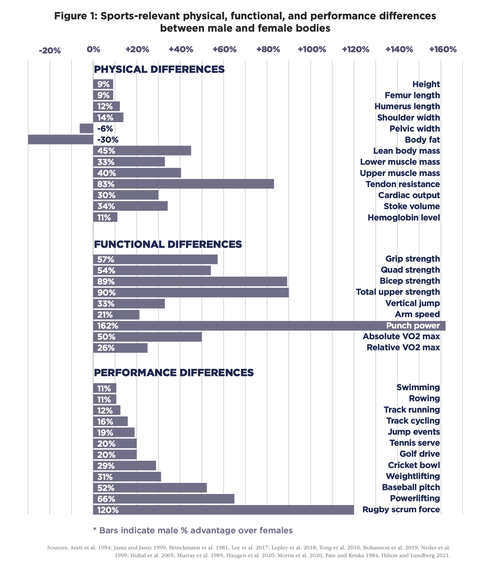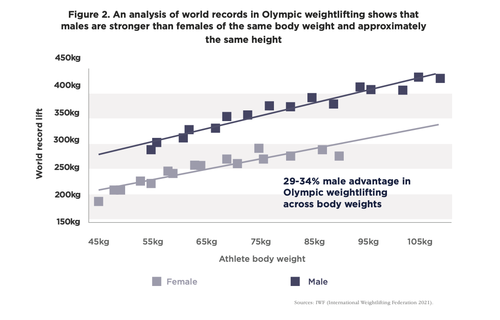Male & Female Athletic Performance: Worlds Apart
by Jon Pike, Emma Hilton, and Leslie A. Howe via Quillette.com

In line with the biology of sexual reproduction and evolutionary pressure on reproductive fitness, males and females are physically different. Physical divergence begins with primary sex development at around seven weeks in utero when, triggered by genetic information inherited at fertilization, bipotential gonads differentiate as either testes in males or ovaries in females. The differentiation and development of gonad type generates a sex-specific hormonal profile that drives ongoing development associated with sex class. Testes contain cells that produce the hormone testosterone, and it is testosterone and its derivatives that mediate the development of male internal and external genitalia, the establishment of growth parameters during high-testosterone “minipuberty” in the neonatal period, and the development of secondary sex characteristics at puberty.
In females, the absence of testosterone production from the developing ovaries permits female internal and external genital development, and the activation of estrogen pathways promotes the development of secondary sex characteristics at puberty.
The secondary sex characteristics acquired during puberty in preparation for reproduction lead to measurably different body morphs between males and females (“sexual dimorphism”) across many physical parameters. Broadly, when compared with females, males are taller and have longer bones with narrower hips and wider shoulders; have lower body fat and higher muscle mass differentially distributed across sites, with more resistant connective tissue; have larger hearts and lungs, and higher levels of haemoglobin, the protein that carries oxygen within the blood.

Male and female athletic performance
The different physical attributes of males and females have functional consequences for sports-relevant outputs. For example, superior muscle mass, particularly in the upper body, leads to greater male strength when compared with female capacity. Greater muscular strength coupled with longer skeletal levers enable males to apply superior force in activities like jumping, throwing, and punching. Males have greater cardiovascular capacity, with higher capacity oxygenation and transport systems.
On average, males can move faster, jump further, throw longer, and lift heavier objects than females, and this creates large performance gaps between males and females in almost all sports. Consequently, when comparing like-for-like athletes (such as male and female elite athletes, or male and female school-level athletes), male records and performances are better than those of females. The smallest performance gaps are evident in sports that require simple manoeuvres with weighted lower-body input, such as running, where females have higher relative (but not absolute) muscle mass. The involvement of upper body muscle mass, and/or complex sports that combine many different functional outputs, yields performance gaps that extend to 30 to 65 percent in weightlifting disciplines and 120 percent in the force applied in a rugby scrum.
An analysis of performance in weightlifting enables comparison between weight-matched (and thus, in many instances, approximately height-matched) males and females. Comparing 2010–2021 world-record lifts by body weight across males and females in weight-restricted categories demonstrates that males are around 30 percent stronger than females of the same size. In a specific example, the current 55kg male record holder, who is 1.52m tall, lifts 29.5 percent more than the current 55kg female record holder, also 1.52m tall. This gap at equivalent body weight and height is, in part, explained by differential body composition where, compared with female total mass, a larger proportion of male total mass is muscle.
When performance gaps are mapped to competitor numbers within a given discipline as a percentage, the impact is obvious and large. For example, the male-to-female gap in track sprinting is 12 percent. This translates into approximately 10,000 males having a personal best 100m sprint time faster than the current female Olympic champion, Elaine Thompson-Herah.
Thompson’s 2016 gold medal performance was, within the year, slower than not just elite senior male sprinters, but also slower than schoolboys, Master’s category males (i.e., age 35 and older), Paralympic males, and males whose primary sport is not track sprinting.

Testosterone, puberty, and athletic advantage
There are athletic differences, probably underpinned by genetic differences and exposure to testosterone during minipuberty that are evident between male and female children at school age. However, school sports tend to promote team play, skill acquisition, and social development, and are therefore usually mixed sex (although promising children may be streamed to dedicated extracurricular sports that are divided by sex).
Notwithstanding these childhood differences, the majority of male athletic advantage appears to be acquired at puberty, when males experience a surge of testes-derived testosterone that results, in adulthood, in circulating testosterone ranging from 8.8–30.9 nanomoles per litre (nmol/l), while female testosterone remains low, ranging from 0.4–2.0 nmol/l. Thus, from puberty into adulthood, testosterone levels between males and females form a non-overlapping, bimodal distribution.
Over several years of male puberty, prolonged exposure to high testosterone is responsible for the development of male secondary sex characteristics such as height and strength, and thus is responsible for driving the divergence of athletic capacity between males and females. This is evident in comparisons of records and performances between elite female athletes and junior male athletes, where schoolboy records in track and field overtake elite female records when those elite schoolboys are around 14 or 15 years old. As Emma Hilton and Tommy R. Lundberg noted in a 2021 Sports Medicine article, ‘Transgender Women in the Female Category of Sport: Perspectives on Testosterone Suppression and Performance’:
Testosterone-driven puberty, as the driving force of development of male secondary sex characteristics, underpins sporting advantages that are so large no female could reasonably hope to succeed without sex segregation in most sporting competitions. To ensure, in light of these analyses, that female athletes can be included in sporting competitions in a fair and safe manner, most sports have a female category the purpose of which is the protection of both fairness and, in some sports, safety/welfare of athletes who do not benefit from the physiological changes induced by male levels of testosterone from puberty onwards.
Given the overwhelming data, we reject arguments that explain male advantage in sport as a by-product of social conditioning, or that cast it as a social construction more generally. That adult human males have a physiological advantage over adult human females in athletic performance is a matter of settled science. But what follows for trans-inclusion in women’s sport?
The effect of testosterone suppression in transwomen
The International Olympic Committee (IOC) regulations for transwomen in female sport, from 2015 to 2021, required transwomen to demonstrate total serum testosterone levels below 10 nmol/l for at least 12 months prior to competition in the female category and during the period of competition in the female category.
As the IOC stated that its “overriding sporting objective is and remains the guarantee of fair competition,” it might be inferred that the IOC and the sports federations that subsequently adopted these criteria understand these regulations to nullify the physical advantages of transwomen, who were all born male and have experienced male puberty. But this view, as the IOC now accepts, is mistaken.
Fair Use Excerpt. Read the whole article here.